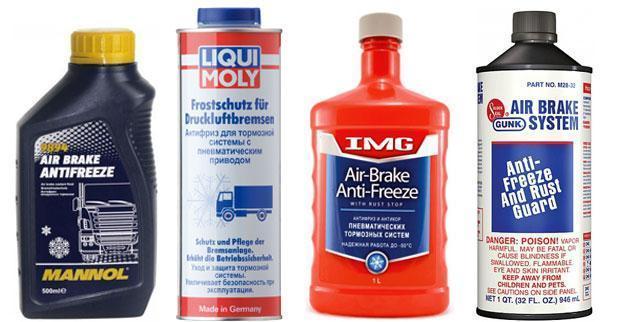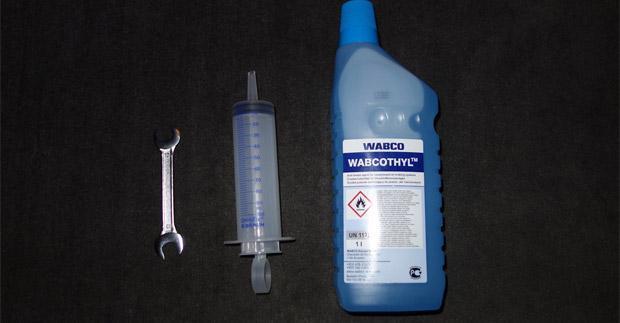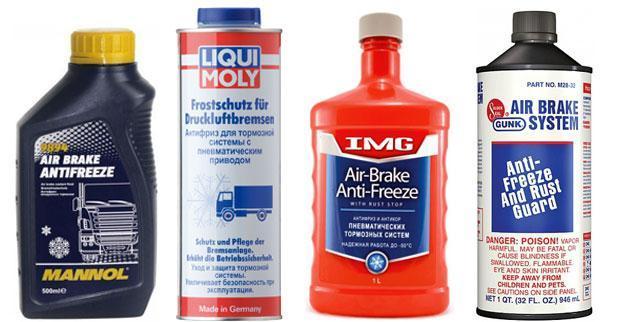
Antifreeze for the pneumatic system. Defrost the brakes
Content
The problem of freezing pneumatic systems
Air contains water vapor. Even at negative temperatures, there is water in the atmosphere. The pneumatic system is not of a closed type, such as hydraulic. That is, air is constantly taken from the atmosphere and, after depressurizing in any circuit, is expelled through the bleed valve.
Together with air, water constantly penetrates the system. If in summer the moisture is almost completely blown back into the atmosphere together with the outgoing air, then in winter it condenses and freezes due to contact with supercooled elements of the pneumatic system.
For this reason, valves, membrane and piston chambers often freeze, even in exceptional cases, the lines themselves are critically narrowed or completely frozen. And this leads to partial or complete failure of the pneumatic system.


How does antifreeze for pneumatic systems work?
Antifreeze for the pneumatic system is an alcohol-containing liquid, the main function of which is to melt ice and prevent the formation of icing. Unlike similar formulations, such as glass defrosters, antifreeze for pneumatic systems mixes well with air and, due to this, penetrates into hard-to-reach areas.
Basically, these fluids are used for the brake systems of trucks. However, they can also be used in other compressed air systems. Alcohols settle on icy surfaces and enter into an isothermal reaction (with the release of heat). The ice turns into water, which subsequently settles at the bottom of the receivers or is expelled through the bleed valves.
Most modern antifreezes for pneumatic systems are chemically neutral with respect to rubber, plastic and aluminum parts. However, precedents are known when the abuse or misuse of this autochemistry led to a disruption in the operation of pneumatics. For example, often unreasonably frequent filling of antifreeze for air brakes is the cause of partial or complete seizure of the pistons acting on the pads due to the formation of a tar layer on the surface of the cylinders.


In the Russian market, two products are most popular:
- Wabco Wabcothyl - the original composition from the manufacturer of the brake system and other technological solutions with a worldwide reputation;
- Liqui Moly antifreeze for air brakes - antifreeze from a well-known German manufacturer of auto chemicals.
Motorists generally speak equally well of these two compounds. However, many emphasize that for the normal operation of antifreeze, it is necessary to fill it only when necessary, and after the scheduled run, it is imperative to drain the condensate.


Where to fill?
It is necessary to fill in antifreeze for pneumatic systems, depending on where exactly the ice plug has formed. And in those cases, if interruptions in the operation of pneumatic brakes or other devices powered by compressed air are noticed.
When the dryer is in normal operation, filling can be done directly into the hole for installing the filter. In some cases, it is problematic to unscrew the filter in winter. Then antifreeze can be poured into the outlet under the filter housing, from which the branch pipe goes into the system.
If the dryer is frozen, it is best to pour antifreeze into the inlet tube or into the cavity under the filter. It is also practiced to fill the system through the intake port on the compressor.


In the event that a plug has formed in the pneumatic system of the trailer, it is necessary to fill in antifreeze only in the central pressure line through which the working air pressure passes. Refilling antifreeze into the control line may not have any effect, since the antifreeze will remain in it and will not pass through the entire pneumatic system.
After a run of 200 to 1000 km, it is necessary to drain the melted condensate from the system. Be sure to empty all receivers, otherwise moisture will mix with air when the temperature changes and again begin to circulate through the lines, condensing in the valve system or actuators.
It is not recommended to pour antifreeze into pneumatic systems in which there are no problems with freezing. Air brake antifreeze should only be used when freezing has already occurred. Preventive use does not make sense and can even harm rubber and aluminum parts.
